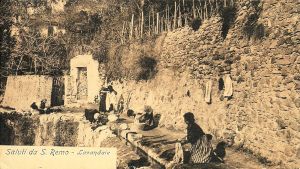Public wash houses and washerwomen
Even though the aqueduct commissioned by mayor Siro Andreea Carli provided the city with water, the problem of water for certain domestic needs remained the same. We are talking in particular about the washing and drying of household laundry.
Naturally, houses were not equipped with running water supply systems, so clothes had to be washed in streams or canals, and electric washing machines would see the light of day almost a century later.  In those days, when it was not possible to do the washing at home (a "lescia" using ashes and boiling water) or in the riverbanks, given the inconvenience and difficulty of the work and also taking into account the fact that houses were poorly equipped to hang clothes such as sheets, bedspreads or other items out to dry, housewives, especially those who could afford it, preferred to pass on the task of doing the washing, at least in spring, to women who took it to the public wash-house. It was then the housewife's job to iron it with a charcoal iron.
In those days, when it was not possible to do the washing at home (a "lescia" using ashes and boiling water) or in the riverbanks, given the inconvenience and difficulty of the work and also taking into account the fact that houses were poorly equipped to hang clothes such as sheets, bedspreads or other items out to dry, housewives, especially those who could afford it, preferred to pass on the task of doing the washing, at least in spring, to women who took it to the public wash-house. It was then the housewife's job to iron it with a charcoal iron.
A category of specialised workers had thus been formed, who worked on behalf of third parties. "Les blanchiseuses", as a famous photographer called his photograph.
These laundresses used ancient, elaborate and laborious techniques, using boiling water, ash as a detergent, soda and Marseille soap.
Whenever possible, but often the professionals had to give it up, lavender or laurel was added to the washing water to perfume the clothes.
When rinsing the linen, "salda", a kind of dressing, was used, mixed with "turchinetto" to give the linen a light blue tint and facilitate the work on the garments to be ironed.
The public wash-houses were created specifically for these purposes, and consisted of one or more tubs with adjustable water, roofs for shelter from the sun and weather, and in some cases, drying racks.
These wash-houses were later set up by the community in various parts of the town. The ones we know of are those in Via Morado, San Costanzo, Porta San Giuseppe and Piazza Bresca.
As can be seen, the area best served was the Pigna.
The ancient district, penalised from the point of view of water and sanitation, found in the public wash-houses an indispensable contribution to the precarious hygienic balance of the time.
(text freely elaborated from various written sources)




